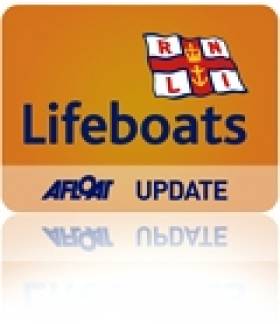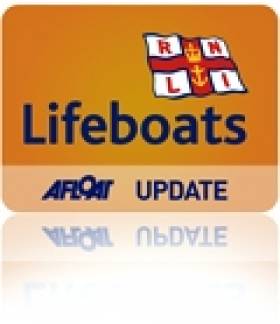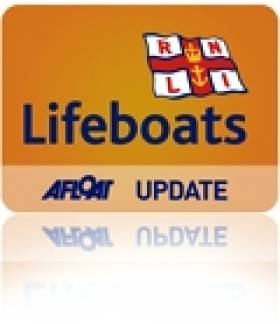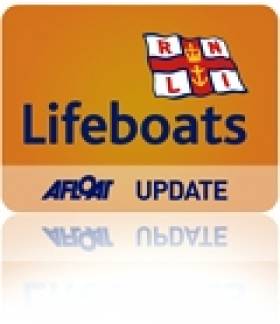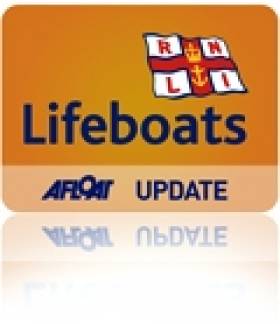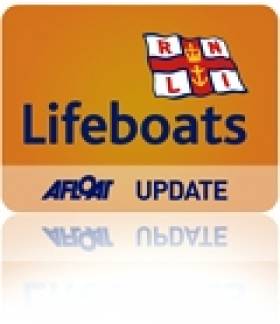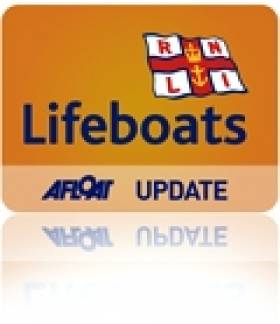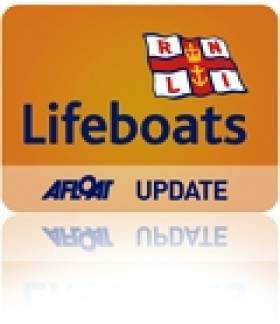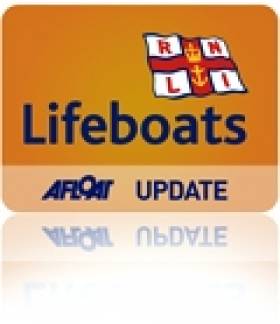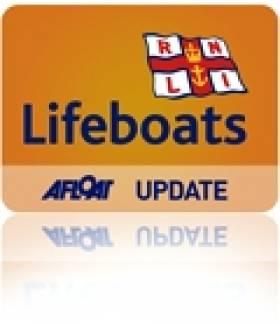Displaying items by tag: Lifeboats
#RNLI - The RNLI’s first permanent inland lifeboat station is now complete and fully operational on Upper Lough Erne in Co Fermanagh.
After been housed in temporary accommodation for 13 years, Enniskilllen RNLI volunteers were handed the keys to their new building in Carrybridge this week.
The modern purpose-built lifeboat station is located close to the lough to allow for an efficient launch of its inshore lifeboat and rescue water craft.
The station, which also houses the associated launching tractor and equipment, full crew changing facilities, a workshop, office and training room, will be officially opened later this year.
First announced nearly two years ago, the build took little over a year to complete was carried out by the Omagh based Woodvale Construction Company and handed over to the RNLI last Wednesday 25 March.
The building is designed with a heating system which allows the heat to be drawn from the ground and produced inside, keeping the temperature at an ambient 15 degrees Celsius. The excess is used to heat the water for showering, washing-up and cleaning the vessels. Solar panels on the roof will also generate electricity for the station's needs.
In order to facilitate the project, the local community helped the charity raise £60,000 towards the cost, which will now help the RNLI’s 40 volunteers based at Enniskillen to continue to save lives on Lough Erne.
In 2001, Enniskillen became home to the RNLI’s first inland lifeboat station based on Lower Lough Erne. Due to the overall size and complexity of the lough and its high leisure usage, the decision was taken by the RNLI in 2002 to base a second lifeboat on the Upper Lough at Carrybridge that would work in conjunction with the original lifeboat station on the Lower Lough at Killadeas.
With two bases, two inshore lifeboats and two rescue water craft, the station has since proved to be one of the busiest in Ireland.
Last year alone, Enniskillen RNLI launched 59 times, bringing 57 people to safety. Some 32 of those services were carried out in the dark while the crew spent 262 service hours on the water.
Speaking following the handover of the new building, RNLI divisional technical manager Derek Potter said he was delighted that the station was now complete.
"From the outset, we wanted to build a modern station with full crew facilities with areas for the crew to change and train and space to keep their lifeboat and rescue water craft and lifesaving kit safe," he said.
"We now have those facilities and are very happy to be in a position to take over the new lifeboat station and are delighted with both the design and quality of the building."
Enniskillen lifeboat operations manager Davey Robinson added that the new station was what the crew deserved.
"The new station is a testament to the RNLI’s commitment and dedication to the community here locally and a credit to our crews efforts in continuing to bring people to safety on Lough Erne," he said.
"Our volunteers had an opportunity to be shown around their new station this week and they are overwhelmed with the structure and facilities that they now have when they come together for callouts and training.
"We would like to thank everyone who has helped us to get to this stage including all those who donated, organised or participated in any fundraising activity."
#RNLI - Fethard-on-Sea RNLI were diverted from a planned exercise last weekend following a report of a young man in extreme difficulty after he launched a kayak near Baginbun Head to rescue his dog from a steep gully.
The young man and his girlfriend, both from Co Wexford, were walking with their dog near Baginbun Headland on the afternoon of Sunday 22 March when the dog fell into the gully while following a seagull.
The man, in concern for his dog, tried to rescue it by getting his kayak, launching it, and going into the gully. Sea conditions were calm at the time and the man was an accomplished boatman with a good knowledge of the seas around Baginbun.
However, as he entered the gully he realised that the sea was rougher than he anticipated. His kayak overturned and he realised that he was going to have difficulty getting out to open water.
Conditions inside the gully were worsening as the tide started to come in. The man alerted his girlfriend who remained on top of the gully to raise the alarm.
Fethard-on-Sea RNLI were on a planned training exercise in the area when the call came through. Lifeboat helm Hugh Burke immediately had the boat launched at Fethard Harbour and went to Baginbun.
The RNLI lifeboat crew established contact with the trapped man and assessed the situation. The lifeboat helm decided to manoeuvre the lifeboat into the gully stern first. The man was rescued by the lifeboat crew but sadly his dog died as a result of the fall.
A coastguard helicopter was on standby in the vicinity in case the man required hospitalisation but this was not necessary.
The RNLI would like to remind the public of the danger of trying to rescue dogs that get into difficulty in the sea or on cliffs and advised the public to contact the Irish Coast Guard.
Red Bay Lifeboat Launches To Aid Lone Yachtsman In Poor Weather
#RNLI - Red Bay RNLI's lifeboat crew went to the aid of a lone yachtsman some 1.5 miles off Glenarm in Co Antrim yesterday evening (Sunday 29 March).
The volunteer lifeboat crew launched at 6.10pm to assist the 25-foot yacht, which was requiring assistance due to adverse weather conditions and strong winds.
- One member of the lifeboat crew was placed on board the vessel to assist the yachtsman.
The boat was towed to Glenarm Marina by the lifeboat crew. No one was injured in the incident.
Wicklow Lifeboat Launches To Rescue Kitesurfer
#RNLI - Wicklow RNLI's all-weather lifeboat launched at 5.10pm on Saturday (28 March) to assist a kitesurfer in difficulty off Potters Point, south of Wicklow Head.
The kitesurfer was unable to get ashore after leaving the beach at Jack’s Hole. One of his friends saw him in the water and immediately contacted the Irish Coast Guard for help.
Conditions in the area at the time had a south-easterly Force 6 wind with a moderate sea state.
"We located the kitesurfer drifting off the south end of the Wolf Rock near Jack’s Hole," said Wicklow RNLI coxswain Nick Keogh after the callout. "He was using the floatation end of the kite equipment to stay afloat, after he got separated from his board."
A first-aid-trained member of the lifeboat crew assessed the casualty as they returned to Wicklow. He had no injuries and did not require any further medical assistance. The man was landed safely ashore at Wicklow Harbour at 6.30pm.
The crew on the callout were Keogh, mechanic Connie O'Gara, Ciaran Doyle, Terry Sillery, Graham Fitzgerald, John Vize and David Collard.
Arklow's nearby RNLI lifeboat was also requested to launch but was stood down by the coastguard as Wicklow took command of the situation.
Mark Corcoran, Arklow RNLI volunteer lifeboat press officer, hailed the "lightning response by both RNLI volunteer crews at Arklow and Wicklow" which "shows the dedication our volunteers have to saving lives at sea".
Corcoran, who is also Arklow's sea safety officer, added: “All persons who take to the water over the coming summer months must always wear their lifejackets and should always have a means of raising the alarm."
Any groups or individuals who would like advice on any water safety issue from kayaking to sailing, angling, kitesurfing or windsurfing can contact Corcoran at 086 826 0439 or [email protected].
Rosslare Harbour Lifeboat Tows Lone Yachtsman To Safety
#RNLI - Rosslare Harbour RNLI was requested by the Irish Coast Guard to assist a 12-metre yacht which had lost all power due to a generator failure at 12.50am in the early hours of this morning (Monday 23 March).
The lone yachtsman, who had set out from Portsmouth for the Isle of Man, had radioed for help as the loss of power with no wind present had disabled his yacht.
Weather conditions at the time were described as very good, with a north westerly wind and a slight breeze.
A tow was established by the volunteer lifeboat crew about 25 miles northeast of Rosslare Europort off the Wexford coast. The lengthy tow saw both arrive safely back into port shortly after 6am.
Commenting on the callout, Rosslare RNLI deputy launching authority Jamie Ryan said: "It was a long night for the lifeboat crew as they made sure the lone yachtsman was brought to safety. He took the correct action in radioing for help and we were happy to assist him."
Howth Lifeboat Rescues Three From Grounded Motorboat
#RNLI - Howth RNLI's all-weather lifeboat launched at 6.30pm yesterday evening (Sunday 22 March) to reports a motorboat was taking on water at the entrance to Malahide Estuary.
The vessel with three people aboard, which had run aground, was quickly located within 12 minutes of launch.
Weather conditions were good at the time on a clear dry night. There was a low tide and Howth RNLI's XP RIB was prepared and launched from the all-weather lifeboat, manned by volunteer crew members David Howard and Ian Sheridan.
The five-metre motorboat was stuck on a sandbank on the falling tide and was taking on water. The water was pumped from the motorboat, which was then refloated.
Its three passengers were taken safely aboard the all-weather lifeboat and brought back to Howth Marina along with their vessel.
Speaking following the callout, Howth RNLI coxswain Fred Connolly said: "We were pleased to have been able to respond and launch so quickly, locate and recover the casualty vessel.
"There was a very low tide this evening, which contributed to the motorboat running aground, but we compliment the three crew members who immediately called for help as soon as they got into difficulty.
"We also thank our colleagues in the Irish Coast Guard who assisted the rescue from the shore.”
#RNLI - The Clifden RNLI volunteer lifeboat crew scrambled into their kit for a special callout recently when they provided a guard of honour for their two fellow lifeboat crew Alan Pryce and Sinéad O’Sullivan, who tied the knot in St Joseph’s Church recently.
The couple met through their life saving work volunteering as crew with Clifden RNLI.
And lifeboats played a big part in their day, from the RNLI guard of honour, to the special stop at the station for a photograph with their beloved lifeboat, to a wedding cake which featured the couple dressed in their full RNLI kit.
O’Sullivan joined Clifden RNLI eight years ago and is the station’s only female crewmember. A trained lifeguard, she is currently training to be a helm on the station’s D-class inshore lifeboat and a navigator on the all weather lifeboat.
For her day job, O’Sullivan is an estate agent and auctioneer and is well known all over Connemara for her enthusiasm and energy and getting involved in many good causes.
Her groom is a fellow Clifden native who signed up as volunteer RNLI lifeboat crew at just 17 years of age, through his interest in fishing and sailing.
Since then Pryce has become helm on the D-class and Atlantic-class inshore lifeboats and is one of the station’s four coxswains on the all-weather lifeboat, which is currently on a two-year trial at the station.
"Being in the RNLI is a huge part of both of our lives so we were really delighted that we were able to incorporate it into our wedding celebrations," said Pryce.
"We both love the sea and share a passion for all water based activities, so it was definitely one of our shared interests that resulted in us getting together."
O’Sullivan added: "We were really thrilled that we could share our wedding with two of our favourite things - the Clifden lifeboat and our beloved dog Pippa."
After the wedding, the couple enjoyed a quick mini-moon to Wicklow where they even stopped in briefly to Arklow RNLI to admire their Trent all-weather lifeboat.
And now that the dust has settled and all the party clothes are put away, the newlyweds are back on service and ready to answer the call of the RNLI pagers.
Women Wanted For Northern Ireland Lifeboat Crews
#Lifeboats - Donaghadee's lifeboat station is putting out a new call for volunteers - and women are particularly welcome, as UTV News reports.
The Ards Peninsula town, just outside of Belfast Lough, hosts one of Northern Ireland's nine RNLI lifeboat stations, which combined accounted for 281 people rescued in 2014.
But only 10% of the North's lifeboat volunteers are women, prompting a renewed appeal by Donaghadee coxswain John Ashwood - who hastens to add that the RNLI is an equal opportunities recruiter.
“At the end of the day, here in Donaghadee, the whole ethos is getting the right person to do the job whether male of female," he says.
UTV News has more on the story HERE.
Bangor Lifeboat Launched To Search For Missing Vessel
#RNLI - RNLI Bangor's lifeboat launched at 7.55pm last night (Saturday 14 March) to search for a missing 12ft RIB with two persons on board after the alarm was raised by Belfast Coastguard.
Within minutes of the rescue pagers being activated, volunteer crew had launched the lifeboat and located the missing boat close to the slipway at Ballyholme Bay.
The vessel had experienced engine failure and had been rowed closer to the shore by the owner.
Calm on-scene sea and weather conditions allowed for a tow line to be quickly rigged and passed to the stricken vessel. The boat was then towed to the safety of Bangor Harbour.
"Engine failure even close to shore could lead to a life threatening situation," said RNLI volunteer helmsman John Bell, who was involved in this rescue.
"We’re glad that the two people on board this boat are now safely ashore."
Bell went on to emphasise the RNLI’s five sea safety tips for anyone going afloat this summer.
"Always wear a lifejacket, secondly check your engine and fuel, thirdly tell others where you are going, fourthly carry some means of calling for help and final always check the weather and tides."
Charity Cycle For Lough Ree Lifeboat
#RNLI - Lough Ree RNLI held a press launch on Saturday (7 March) to announce their upcoming Lap of Lough Ree charity cycle, which will take place on Sunday 29 March.
The cycle will start and finish at The Bounty, Buccaneers Rugby Club in Athlone, and will travel north through Ballymahon, cross the Shannon at Lanesboro Bridge and complete the 85km lap of Lough Ree, travelling south on the Roscommon side, via Kilteevan, to cross again at Athlone Bridge.
Lough Ree RNLI relies on public donations to fund its operation, and the Lap of Lough Ree is an important fundraising event for the charity organisation.
Lough Ree's lifeboat station was the busiest in Ireland in 2014, so maintaining a high standard of service in the area is vital.
Brendan Finnegan, Lough Ree RNLI fundraising committee chairman, said: "We run a variety of events throughout the year to raise funds and we are privileged to have a huge level of support in the community.
:The cycle was very popular when we first organised it last year and it is a pleasure to run events that participants can get actively involved in. We are hoping for a big turnout again this year."
Registration for the event will take place at 9am on Sunday 29 March at The Bounty, with the cycle starting at 10am.
Snack packs will be provided to all entrants, and refreshments will be provided midway at Lanesboro and also at The Bounty afterwards on return. Subject to numbers interested, an extended route may be arranged for cyclists who enjoy a more challenging ride.
The entry fee is €25, and entry forms available at Facebook.com/LoughReeRNLILifeboat
In other fundraising news, Paddy McCrossan and Seamus Fuery of the Organisation of National Ex-Servicemen (ONE) in Athlone presented a cheque for €500 to Lough Ree RNLI on 3 March last.
The ONE are stalwart supporters of Lough Ree RNLI, volunteering each year to help with collections on RNLI’s national Flag Day and maintaining RNLI collection boxes in their mess.
Lifeboat operations manager Damien Delaney said: "It’s good supporters like ONE that enable the lifeboat crews to respond to calls when they are needed, and we are grateful for their continual support since the Lough Ree lifeboat station opened."


























